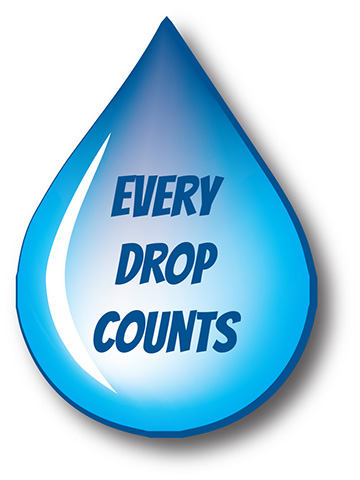Water! Do something now before it runs out!
By: Christine McLean, Eco Promotional Products, Inc.
Why conserve water? Let's start with some facts. Only 1% of the earth's water is available for drinking. In the United States alone, we drink about 110 million gallons of water! And the Environmental Protection Agency sites that a typical household uses approximately 260 gallons of water every day. Yet the US Drought Monitor posted a geographic map April 10, 2014, depicting more than 50% of the United States experiencing abnormally dry to exceptional drought conditions that threatens our water sources. According to the Water Resources Group, globally, demand for freshwater will exceed supply by 40% by 2030. Even if you live in a region with ample water and rainfall, many areas in the world have serious depletion or pollution of their fresh water sources. In fact, 783 million people do not have access to clean water. It's time to take water conservation seriously and there are many simple things you can do to
make a difference.
Outdoors – what you can do to reduce your water use:
Did you know, nearly 60% of a person's household water footprint usually goes toward lawn and garden maintenance? Take these steps to help reduce your use of outdoor watering:
- Water early in the morning or later in the evening.
- Set a timer when watering.
- Adjust sprinklers to make sure only your lawn is being watered (not the house, driveway, sidewalk or street).
- Hand water small areas.
- Don't water on windy days
- Water plants deeply but less frequently.
- Use drip irrigation for trees, shrubs and flower beds.
- Collect rain water from your roof in rain barrels to water vegetable gardens, pots and more.
- Plant drought-resistant plants then mulch to keep in moisture.
Here are more outdoor changes you can make with Eco Promotional Products tools:
- Use a moisture meter to check the moisture in your garden (Moisture Meter)
- Use a rain gauge. Knowing how much rainfall has been received makes it easier to adjust lawn sprinklers (Rain Gauge)
- Wash your car with a self-closing nozzle (Low-Flow Hose Nozzle)
Indoors – what you can do to reduce your water use:
You can make small changes in the kitchen, laundry room and bathroom. Nearly 22% of indoor home water use comes from doing laundry. Save water by making sure to adjust the settings on your machine to the proper load size or wait until you have a full load. If possible, use a water-efficient washing
machine. The same is true for a dishwasher. Install a water/energy-efficient model and only run it when it is full. Never throw out unused water sitting in bottles or glasses or water used for rinsing fruits and veggies etc. Use it to water house plants or potted plants outdoors. In the bathroom turn off the water
while washing your face, brushing your teeth or shaving. When possible take a shorter shower instead of a bath and install a low-flow shower head. Check for leaky faucets as they can waste up to 100 gallons of water a day. Here are more indoor changes you can make with Eco Promotional Products:
- Reduce your shower to 5 minutes, (Recycled Shower Timer)
- In general, you can stop purchasing individual bottled water. Not only is the plastic bad for the environment but the amount of water going into making the bottle could be up to six or seven times what's inside the bottle. Also, consider the transportation and carbon emissions for transporting bottled water. Eco Promotional Products offers a huge variety of reusable water bottles.
- Test your toilet for leaks once a year (Toilet Leak Detection Tablets)
And last, EPP offers a Water Conservation wheel that contains valuable every day water conservation procedures that can be practiced at home. This is a great educational tool for both children and adults!
You can also get involved and donate time and/or money to water conservation organizations throughout the country and globally. Here is a list of a few great organizations:
• Soil and Water Conservation Society
• Partnership for Water
• Alliance for the Great Lakes
• Water Environment Federation
• Miya
• Water is life
• US Water Alliance
Sources: National Geographic, Save Our Water, EPA, US Drought Monitor, Water Resources Group, Water Footprint Network, Unwater



